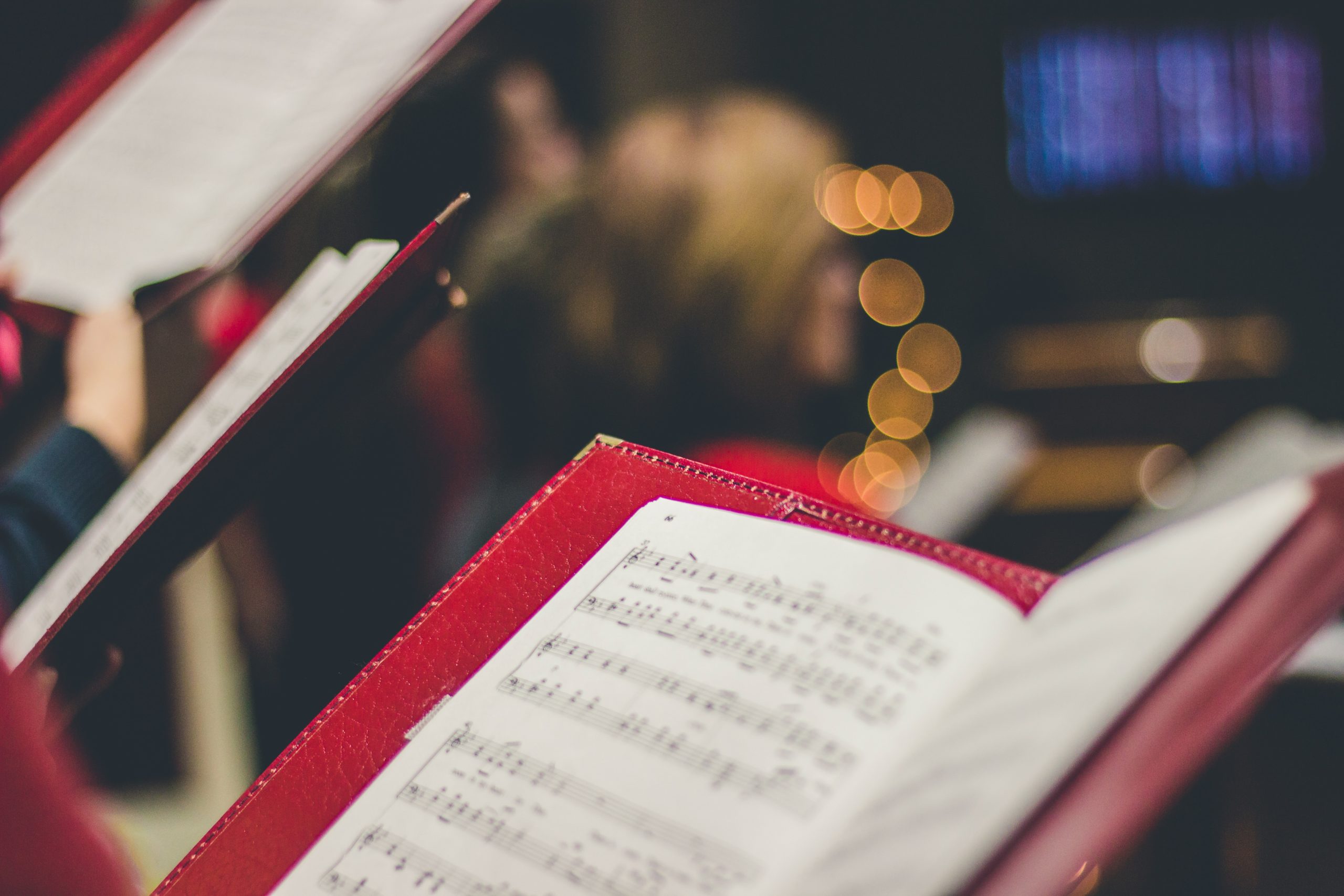
The Chorister’s Tale: Religious Freedom Analogies in the COVID Pandemic
M. Christian Green
Photo by David Beale on Unsplash.
No one has heard a peep from this chorister in nearly a year. Trained in law, religion, and the law of religious freedom, there was a time early in the pandemic when I wondered whether the social distancing mandates being adopted by state and, in some cases, municipal governments would be experienced by some as an infringement upon religious freedom. My own Louisiana congressman was one of the earliest voices on pandemic church attendance as a matter of religious freedom, and a Louisiana pastor has recently taken his resistance to civil authority to such extremity that the United States Supreme Court met his application for a hearing with a swift decline.
But the recent Supreme Court rulings on religious freedom under COVID have indulged in liberties of analogical reason that have themselves become examples of extremity. In Roman Catholic Archdiocese v. Cuomo, Justice Gorsuch analogized religious congregations to liquor stores, bike shops, and even massage parlors. The Court’s latest decision in South Bay United Church v. Newsom saw Justice Gorsuch, joined by Justice Thomas, again indulge in unusual analogies, this time taking umbrage at the exemption in the California law permitting Hollywood film studios to film live choral performances. Justice Gorsuch’s insistence on absolute neutrality between religious congregations and secular film studios evinces a declination of distinction that arguably might undercut the distinctiveness of religion that he, and the First Amendment, purport to protect. In the pandemic, choirs themselves have manifested this distinctiveness mainly through a response of solemn silence — a necessary silence under the circumstances.
One key facet of this pandemic has been not only its omnipresence in our daily lives, but how relentlessly it emphasizes our necessary connection to others.
To understand why, let’s begin with the science. National and international studies have documented the incidence of COVID in choirs. In a notorious case in Skagit Valley, Washington, 53 of 61 chorus members contracted COVID after one 2.5-hour choir rehearsal. A series of rehearsals by a choir in the Netherlands resulted in 102 members of the 131-person choir contracting COVID, and one choir member and partners of three others died from the disease. After a Berlin Cathedral Choir rehearsal, 60 of 80 participants contracted COVID. In South Korea, 5,000 cases of COVID were attributed to attendance at the Shincheonji Church of Jesus. After a performance by a Christian singer at a church in Berrien Springs, Michigan, the singer and two members of her staff were found to have COVID, although thankfully, there was no reported transmission to the audience. These represent just a few of the incidents that prompted medical associations, eventually including the CDC, to recommend against choral performances of all sorts, though the CDC, eventually and controversially, rescinded its initial recommendation.
It is indeed the case that not all of these choral outbreaks were linked to churches; some were secular choirs. Moreover, most church choirs are not 80 or 100 choristers strong. Many of us in church choirs would be excited — really, elated — to achieve a mere dozen choristers, especially with a good balance among the four voices of a standard SATB choir. Church choirs are mostly voluntary. Very few of us are paid to be there, though some churches are fortunate enough to be able to hire a talented young voice or two from local high school and university programs. Our singing, we hope, stirs people’s souls and rouses people’s spirits, but we are not a massage parlor. Nor are we a Hollywood film studio, where paid and unionized actors — not to mention stuntpersons and body doubles — practice their craft in a controlled environment, largely able to be insulated from infection through required testing, vaccination, and cancellation or limitation of studio audiences and tours.
Admittedly, the Hollywood film studio is not entirely risk-free. As the boilerplate warning goes, “These stunts are performed by paid and trained professionals. Do not try this at home.” But film studios are a different environment from churches, which often aspire to welcome everyone, but also have little control over who might leave their homes to attend services and what levels and regularity of COVID mitigating procedures — masks, testing, and social distancing — they may be practicing at home or may be subjected to in the communities in which they live and work. The religious congregation is likely to be only as safe as the community in which it is located.
That very act of self-assertion, whether between self and community or self and God, is the theological definition of sin in the Christian tradition.
A recent forum of the Berkley Center for Religion and World Peace on “COVID Vaccination Challenges: Ethical Imperatives and Local Realities,” focusing particularly on the global dimension but with lessons for local communities, emphasized that “no one is safe until all are safe.” Indeed, one key facet of this pandemic has been not only its omnipresence in our daily lives, but how relentlessly it emphasizes our necessary connection to others. For practitioners of religare, or re-binding, there can be no absolute assertions of “my rights” or “my freedoms” in community, since we are all bound inextricably to one other. That very act of self-assertion, whether between self and community or self and God, is the theological definition of sin in the Christian tradition. In that sense, the real shock is not that choirs are banned, but why churches would be allowing them at all.
There remains yet another unusual feature of Justice Gorsuch’s analysis. At one point in his South Bay decision, Justice Gorsuch observes, “Even if a full congregation singing hymns is too risky, California does not explain why even a single masked cantor cannot lead worship behind a mask and a plexiglass shield. Or why even a lone muezzin may not sing the call to prayer from a remote location inside a mosque as worshippers file in.” Cantors are a staple of the Jewish tradition, also sometimes found in Christian denominations. Muezzins are uniquely identified with Islam. There are also the famous chants of Tibetan Buddhist monks and other varieties of choral and chant performance among the world’s religions. But the group choir is largely associated with Christian denominations ranging from African American, to Orthodox, to Latter-day Saints, just to name a few celebrated choral traditions. Does Gorsuch really propose to distinguish and privilege some denominations’ choral practices over others? How will the courts adjudicate this bureaucratic management of choirs? Should Episcopal churches such as my own appoint a designated chorister to broadcast plexiglass-enclosed solos from a high belltower?
Justice Barrett’s brief paragraph of an opinion, joined by Kavanaugh, has been described as not going as far as Justice Gorsuch’s conclusion that religious choirs, as opposed to Hollywood film choirs, were being unconstitutionally singled out and discriminated against in the California law. In her analysis, “It remains unclear whether the singing ban applies across the board (and thus constitutes a neutral and generally applicable law) or else favors certain sectors (and thus triggers more searching review).” One analyst has speculated that Justice Barrett’s opinion in South Bay may indicate a moderation in her judicial philosophy that may not go so far in the direction of untrammeled religious freedom as to, say, overrule the Employment Division v. Smith decision, the inspiration for national and international religious freedom legislation, that is widely speculated as being targeted for elimination by the conservative wing of the court in an upcoming decision on LGBTQ rights.
We may not be singing for the time being, but we are taking care of ourselves and our community out of the profoundly religious conviction that “no one is safe until all are safe.”
The possibility of a Smith overrule based on the argument that religions are entitled by their special and distinctive natures to exemption from neutral and generally applicable laws, such as those governing choirs in congregate settings in the COVID, would upend the American religious jurisprudence established — however fitfully and, at times, inconsistently — over the last three decades. But recent Supreme Court decisions seem poised to accord religion special status qua religion in a way that could threaten the balance of the Religion Clauses of the U.S. by elevating Free Exercise Clause and the jettisoning of the Establishment Clause. The COVID religious freedom cases are an odd vehicle for this outcome, however, especially in light of Justice Gorsuch’s own argument about neutrality.
After all, when it comes to COVID precautions, religious congregations really do seem different from other organizations. Medical associations have identified the particular risks from in-person religious services, particularly those with choirs, chanting, or other vocal worship practices. According to a Pew Research Center survey, nearly 80% of American Christians oppose religious exemptions from COVID precautions and say houses of worship should be subject to the same social distancing requirements as other organizations. Choral directors lament, but accept, that “choirs may have to remain silent long after society reopens.” But even with worship services moved largely online, many Americans report that COVID has strengthened their religious faith.
The good news for congregations and choirs in the U.S. is that while many have adapted readily to online worship, most are looking forward to getting back together. In many religious congregations, choirs are recognized as part of the ministry of the church, and while silence now prevails, we will be singing new songs in due course. In that ministerial context, it remains significant and somewhat ironic that even as the courts and lawyers fret over analogies and abstractions in the name of choral religious freedom, those of us in choirs, along with many in our congregations, are happy to pipe down. We may not be singing for the time being, but we are taking care of ourselves and our community out of the profoundly religious conviction that “no one is safe until all are safe.” ♦

M. Christian Green is a senior editor and senior researcher at the Center for the Study of Law and Religion. Her areas of scholarly expertise are law, religion, human rights, and global ethics.
Recommended Citation
Green, M. Christian. “The Chorister’s Tale: Religious Freedom Analogies in the COVID Pandemic.” Canopy Forum, March 10, 2021. https://canopyforum.org/2021/03/10/the-choristers-tale-religious-freedom-analogies-in-the-covid-pandemic/

